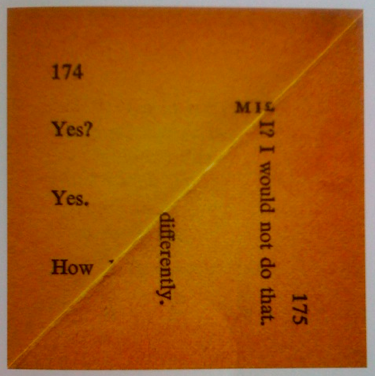
I became a member of the amazing and incredible Ugly Duckling Press this year. I'm happy. I got Dog Ear in the mail a few weeks ago. I'm even happier.
The concept behind these dog ears is clear from the outset. Someone (that someone being Erica Baum) has decided to take photos (or scan?) dog-eared pages of books. Out of these small squares of bisecting text emerge small puzzles, small challenges to the reader to re-learn how to read.
Initially, I found the squares curious. I was drawn into looking at them, attempting to read them or to decipher them. Should I read the words that were cut in half? What if the majority of the word was there, but just a piece of it was missing but I still felt like I could reasonably infer what the word would have been? Did the word exist then? How to read the tiny tips of a serif l or the squiggly lines and dots of the remainders of letters? I was puzzled, unsettled, put off, intrigued.
Kenny Goldsmith's introduction (which is (fittingly for Goldsmith) partially plagiarized from Dick Higgen's 1987 book on pattern poetry) helps us navigate the poems with his reference to the traditions of leonine verse. Higgins points out that this kind of poetry is difficult to define (Goldsmith says it's difficult to "explain") and then they both provide the same example of this sort of verse:




We are immersed in a world of choose-your-own-adventures, Goldsmith says. And I would add that they seem like small mindtwisters, mindteasers, prodding us on and poking us out of a passive reading position. Reordered or re-read in multiple ways, each text has a seemingly infinite number of readings, which made me think about the way this is a facet of most of the poetry that engages me (and the same is true for other forms of writing and art as well). We've stumbled onto an axiomatic truth about the multiplicity of possible readings of a literary text. However, Baum pushes us to think about this in an even more extreme, deranged (rearranged) kind of way. Whenever we read, we are forced to make decisions: in a long novel, we skip paragraphs or skim sections, breezing past character or situations we'd rather not dwell on. Perhaps there is a particular kind of writing or language we like in a particular book and another kind we are not so fond of, well, this propels us to make decisions as we read about how we are to read. Baum makes this process visible, forcing us to reconsider, rethink and reanimate our reading experience. With the turn of each page, we're confronted once again with the doubt: how is this to be read?
The books Baum has chosen to dog ear are hardly random. Goldsmith recommends trying to do this process with other books around you in your home in order to quickly realize just how difficult it is to make something provocative. Hopefully, this will help you to understand just what Baum's "accomplishment" really is. Baum has chosen what are all prose books (actually mass-market paperbacks) for her dog-earing. So there are words which are broken in half by dashes due to prose conventions about typesetting. How do we read these words in this poetry when necessarily they are not continued on the next line? How does this help us to think about the gap between prose and poetry? How does it make us aware of the very conventions of prose and poetry?
Some of the plates are easier than others to read. One of the more "transparent" ones is Plate XVI, Differently:

This small piece is strangely satisfying, pleasurable, even calming, mainly because there are so few extraneous bits of words: "174," "175," "MI," plus a strange squiggly shape next to "MI" and then a tiny little serif tip next to how. In comparison with all of the other dog ears, this one seems plain and clean. It's as close as we get to easy reading in the book, I think. And yet, even this one can be read in so many different ways, as Goldsmith points out in the introduction and Eileen Tabios points out in her engagement with the book.
Other squares are more dense, more crowded and more full of bits of words that stymie easy reading. Compare the experience of reading that first plate with this one, Plate VI Fallout:

Clearly this one is more of a struggle, more of a puzzle, more of a challenge for reading. "It" is cut off. A parenthesis is closed but never opened. Dashes lead into the ehter. A half "C" at the very bottom threatens. The serif tip of a "t" morphs into a bit of an "e" and then "d." But yet the title of the poem, Fallout, alludes to this kind of breakdown, this lingering radioactive cloud post-explosion.
The book is a joyful kind of hard reading, a kind of difficulty that challenges, the kind of difficulty Charles Bernstein has written about in the Attack of the Difficult Poems. I think Dog Ear is a perfect book to learn how to find the fun in reading poems that ask the reader to work, poems that ask the reader to participate, engage, judge, decide, involve themselves. Poems that force the reader to do more than simply sit back smugly in their chair and delight in a singular revelation.
No hay comentarios.:
Publicar un comentario